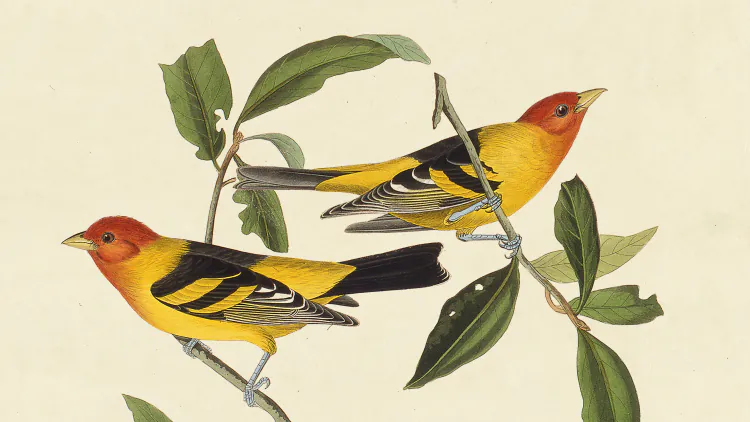Birds Can’t Keep Up With Climate Change
It's creating a mismatch between migration and their food supply.

This article was originally published by High Country News.
At a glance, the male western tanager looks like a little flame, its ruby head blending seamlessly into its bright, lemon-colored body. Females are less showy, a dusty yellow. The birds spend their winters in Central America and can be found in a variety of habitats, from central Costa Rica to the deserts of southeastern Sonora, in western Mexico. In the spring, they prepare to migrate thousands of miles to the conifer forests of the Mountain West, flying through grasslands, deserts, and occasionally, suburban yards.
To fuel them on their lengthy journey, western tanagers fill up on insects and berries. Like most migrating birds, they eat enormous amounts of food. But as global climate change causes spring to start earlier, birds such as western tanagers are arriving at their destination after what’s known as “green-up,” when flowers begin blooming and insects emerge. According to a study published in early March in the journal PNAS, this kind of timing mismatch between migrants and their food sources, which is happening across North America, could have dire consequences for migratory birds’ survival. “In discussing climate change, we often focus on warming,” says Scott Loss, a professor at Oklahoma State University and a co-author of the study. “But the length and timing of seasons—like when winter ends and spring begins—are some of the most dramatic effects of climate change.”
Loss and his colleagues used satellite imagery from 2002 to 2021 to calculate the average start of spring green-up along the typical migration routes of 150 North American bird species, then compared that timing with the current green-up. They found that spring is indeed beginning earlier along birds’ migration routes. The trend continued this year, when, following an unusually mild February, leaves and blooms emerged well ahead of schedule along the West Coast, making this year’s green-up the earliest on record in some areas.
The authors then turned to a trove of citizen birders’ observations from eBird to track bird migration. The analysis showed that, as spring shifted earlier, roughly 110 of 150 bird species failed to keep up by migrating in time. “A lot of these birds were tracking long-term averages of green-up more closely than they were current green-up,” says Ellen Robertson, a co-author of the study who was a postdoctoral researcher at Oklahoma State when conducting this research. Other studies have found that many bird species are adapting to climate change by migrating earlier, but this study shows that it might not be early enough to keep up with the pace of climate change.
“The paper continues to build this picture of the extent and pervasiveness of an inability of birds to track the changing seasons caused by climate change,” says Morgan Tingley, an ornithologist and associate professor at UCLA. Timing mismatches between birds and their food could affect whether birds survive the migration and how many chicks they have. A recent study from Tingley’s lab showed that songbirds that reach their spring breeding grounds either earlier or later than plants emerge have fewer young than the ones that arrive on time with the start of spring, for example.
Previous studies have mainly focused on songbirds in Eastern North America, Tingley says, but this new investigation shows that bird species in the West and at different levels of the food web might be just as vulnerable. However, Tingley notes, some questions remain unanswered. For example, he says that although previous studies show that a timing mismatch could have grave consequences for herbivorous songbirds, it’s unclear if the same is true for birds that feed on other animals, such as insects.
The awe-inspiring feat of migration has captivated humans for millennia, yet scientists have limited knowledge of how birds manage to fly as far as they do, up to tens of thousands of miles a trip, or why exactly they leave when they do. The migratory cues that birds rely on are myriad: temperature, day length, landforms, the stars, even the Earth’s magnetic field, as well as the instructions coded in their genetics. Some of the environmental cues, such as temperature, are likely affected by climate change. But others, such as day length, are not. “That might be one reason some [migratory] birds are more affected by climate change” than others, Robertson says.
Birds that migrate longer distances had a greater mismatch between green-up and migration, the study found. The researchers suspect that’s because even if birds are tracking temperature or other migration cues at their winter home, they can’t know what conditions are like farther away—whether spring is arriving earlier along their migration route or at their destination than it did at their winter headquarters. Long-distance migrants also tend to rely more on their genetic encoding to tell them when to begin their journey.
[Read: The quiet disappearance of birds in North America]
Worldwide, bird populations are in decline. The number of birds in North America has dropped by roughly 30 percent since 1970. Even abundant species, such as crows, have suffered a population dip. Scott Loss says that the migration research could inform conservation efforts in the future. “Part of it is knowing which species are vulnerable to various threats,” Loss says. “This adds to the knowledge about vulnerability of a wide range of bird species.” And he hopes that the information will serve to highlight the urgent need to lower greenhouse-gas emissions as fast as possible: “It’s really important, if we can’t address climate change immediately, to try to stop habitat loss as much as we can.”
What's Your Reaction?




















